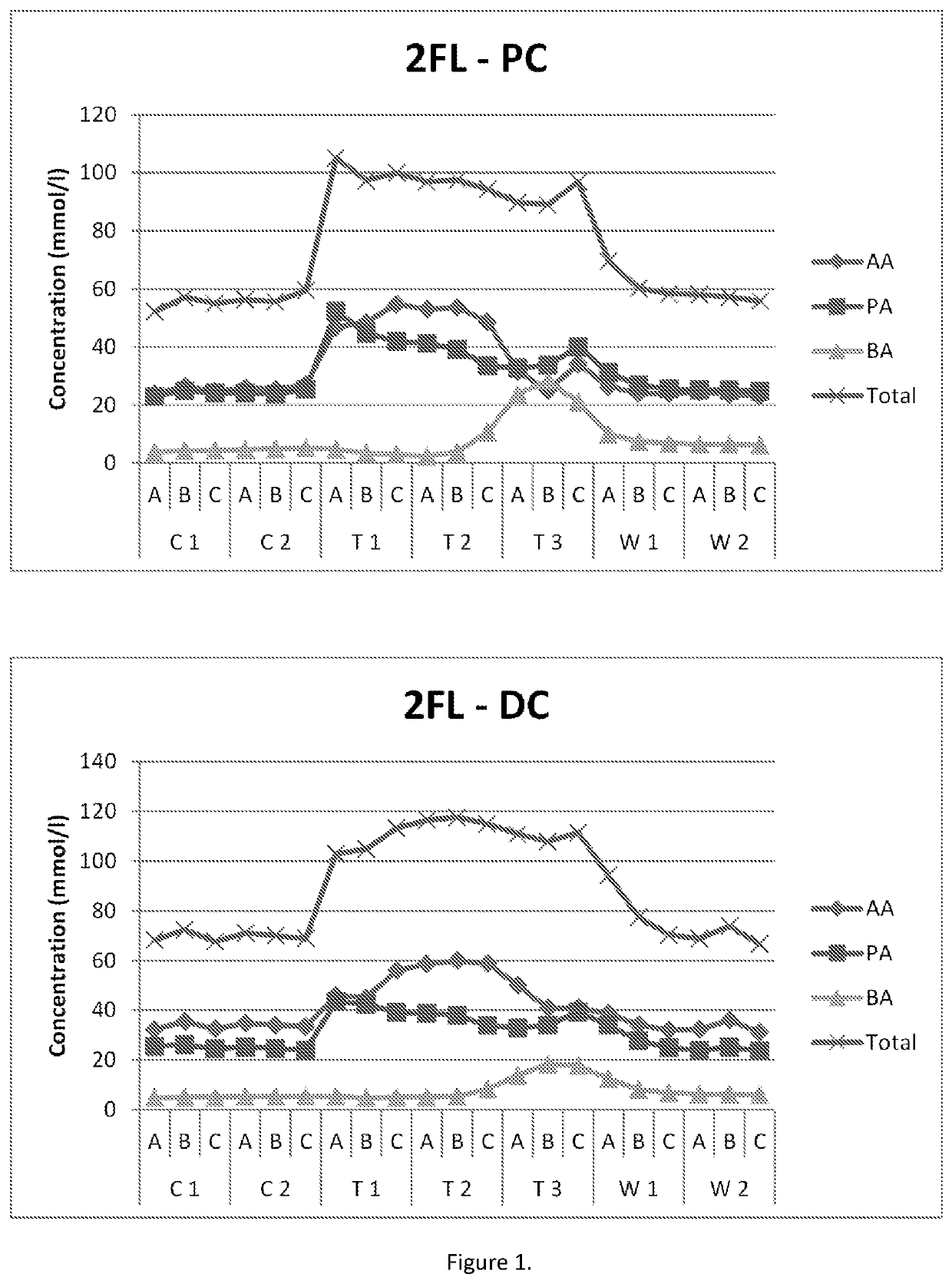Mixture of hmos for treating autoimmune diseases
a technology for autoimmune diseases and hmos, which is applied in the direction of immunological disorders, drug compositions, metabolism disorders, etc., can solve the problems of reducing life quality, organ damage and malfunction, and autoantibodies causing tissue damage, etc., and achieves the effect of impaired intestinal barrier function
- Summary
- Abstract
- Description
- Claims
- Application Information
AI Technical Summary
Benefits of technology
Problems solved by technology
Method used
Image
Examples
example 1
[0094]A total of 100 male and female healthy adults are recruited to participate in the study. After a screening visit and run-in period of 1-2 weeks, the participants are selected and randomized into ten groups, each of 10 subjects. One group is administered a placebo product containing 2 grams of glucose. The remaining 9 groups are administered treatment product containing a) 20 g of 2′-FL, b) 10 g of 2′-FL, c) 5 g of 2′-FL, d) 20 g of LNnT, e) 10 g of LNnT, f) 5 g of LNnT, g) 20 g of a 2:1 mixture of 2′-FL and LNnT by weight, h) 10 g of a 2:1 mixture of 2′-FL and LNnT by weight, and i) 5 g of a 2:1 mixture of 2′-FL and LNnT by weight for 4 weeks. The placebo and treatment products are in powder form in a unit dosage container.
[0095]The healthy adults are eligible to participate if they are at an age between 18-60 years. All recruited participants are able and willing to understand and comply with the study procedures. Participants are excluded if: they had participated in a clini...
example 2
[0110]The anti-inflammatory effect of HMOs is investigated in the non-obese diabetic (NOD) mouse model of diabetes and Sjögren's Syndrome.
[0111]The mice are divided into four groups (n=8) with a control group receiving standard tap water, and the three treatment groups receiving supplementation with 2′-FL, mixture of 2′-FL and DFL (in a 4:1 ratio by weight), or 6′-SL in the drinking water, corresponding to a human daily dose of about 10 grams (calculated by metabolic rate and daily water consumption of NOD mice strains).
[0112]The mice receive the treatment for 12 weeks with bi-weekly water changes. From 12 weeks of age, the blood-glucose levels of the mice are checked weekly. Mice with blood-glucose levels above 7 mmol / l are closely monitored and euthanised (and excluded from the study) if their blood glucose levels increase to ≥12 mmol / l on two consecutive measurements.
[0113]After 12 weeks treatment the mice are euthanised, and the following are sampled; serum, pancreas, salivary g...
example 3
[0120]The impact of the HMOs on microbiota was investigated in the M-SHIME® (M-TripleSHlME®) in vitro gastrointestinal model (Prodigest). The typical reactor setup of the M-TripleSHlME® consisted of a succession of four reactors simulating the different parts of the human gastrointestinal tract. The first two reactors were of the fill-and-draw principle to simulate different steps in food uptake and digestion, with peristaltic pumps adding a defined amount of SHIME feed (140 ml 3× / day) and pancreatic and bile liquid (60 ml 3× / day), respectively to the stomach and small intestine compartment and emptying the respective reactors after specified intervals. The last two compartments were continuously stirred reactors with constant volume and pH control. The retention time and pH of the different vessels were chosen to resemble in vivo conditions in the different parts of the colon. The proximal colon was set to pH 5.4-5.6 and retention time=12 h, and the distal colon was set to pH 6.0-6...
PUM
| Property | Measurement | Unit |
|---|---|---|
| concentrations | aaaaa | aaaaa |
| weight | aaaaa | aaaaa |
| weight | aaaaa | aaaaa |
Abstract
Description
Claims
Application Information
 Login to View More
Login to View More - R&D
- Intellectual Property
- Life Sciences
- Materials
- Tech Scout
- Unparalleled Data Quality
- Higher Quality Content
- 60% Fewer Hallucinations
Browse by: Latest US Patents, China's latest patents, Technical Efficacy Thesaurus, Application Domain, Technology Topic, Popular Technical Reports.
© 2025 PatSnap. All rights reserved.Legal|Privacy policy|Modern Slavery Act Transparency Statement|Sitemap|About US| Contact US: help@patsnap.com

